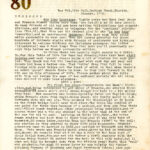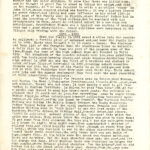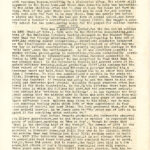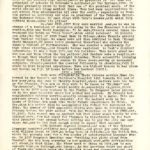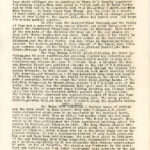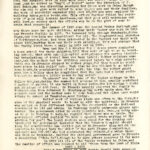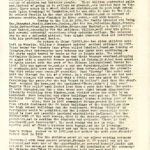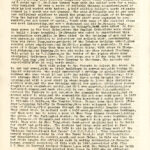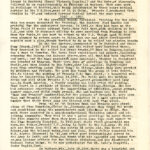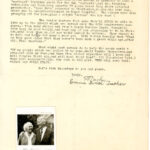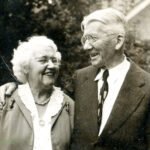Pine Mountain Settlement School
Series 09: BIOGRAPHY – Staff
Series 14: MEDICAL
Dr. Emma Boose Tucker (1870-1963)
Dr. Francis Fisher Tucker (1870-1957)
School Physicians, PMSS Infirmary 1942-1951
80 YEAR ANNIVERSARY
1951 Narrative
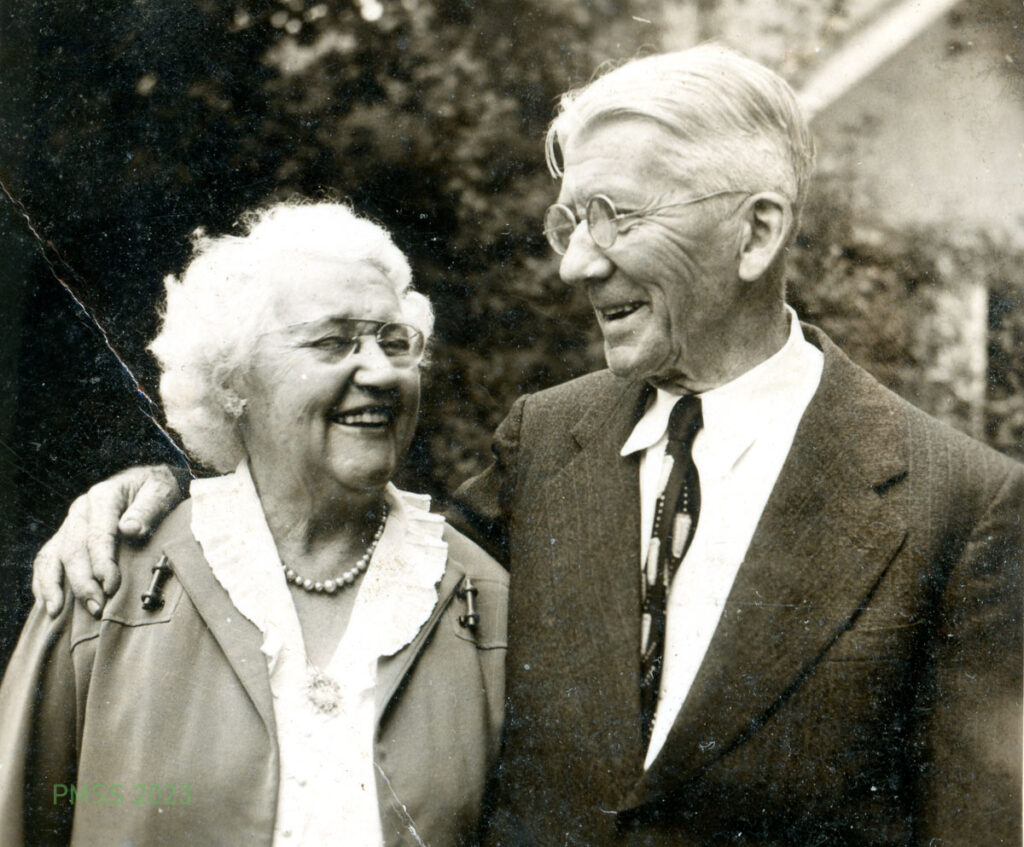
Dr. Emma Tucker and Dr. Frances Tucker, 80th Anniversary. [tucker_80th_anniversary_1951_012.jpg]
TAGS: Dr. Emma Tucker, Dr. Francis Tucker, Pine Mountain Settlement School physicians, rural medicine, Tuckers’ 80-year anniversary, medical colleges, medical service in China, Nebraska Christian Endeavor Union, William Boose Tucker, Margaret Emmeline Tucker, Pang Chuang medical plant, Myra L. Sawyer, R.N., American Board hospitals, American Red Cross in China, Arthur Smith Tucker, Francis Carlile Tucker, Chinese International Famine Relief, Grace Feng, Chinese International Red Cross, WWII
Dr. EMMA and Dr. FRANCIS TUCKER 80 Year Anniversary 1951
TRANSCRIPTION
[NOTE: The following transcription has been slightly edited for clarity.]
001
NOTES on EIGHTY YEARS, – especially for relatives and close friends, some of whom have long urged that this Life History be outlined.
…0lds Hall, Daytona Beach, Florida.
January, 1951.
PROLOGUE
New Year Greetings. Eighty years ago Emma Jane Boose and Francis Fisher Tucker were born (she Oct. 20 & he 22 days later). So many friends of old and new have written felicitations and congratulations, and sending cards or telegrams for the ‘combined’ celebration (Nov. 23), that they use the present plan to say “pu kan tang” (unworthy), and an underscored thankyou. How they wish they could write personally to each one! They are indeed grateful for these hundreds of intimate visits with friends of yesteryear and today, as witnessed by welcome birthday and Christmas messages. One letter (illustrated) was 9 feet long! They feel sure you’ll generously accept this letter as though personally written.
In China there are usually eight guests to a table. So, for this Table of Life for Emma and Francis, there have been eight decades, and each ‘guest’ decade holds a bit of history for each period. They thank God for His leading, and wish each day and year and decade had been a better one. That ‘table’ they find full to over-flowing with good things, not the least of which is that when there’s an added ‘guest’ decade there is room. So they look forward to the 9th one in this afternoon of life. Please gather about the table with them and review the saga of two ordinary mortals who all along have desired to make less mistakes.
1870-1880
The first ten years. Pennsylvania was Emma’s birthplace and being determined to get ahead of Francis, she started three weeks earlier and avers she’s still ahead, though her hair is a bit whiter than his! Her ancestry was German-speaking Swiss and English-Irish, while Francis stems from Anglo-Saxon stock. Her family moved to S.E. Nebraska when she was six. They crossed the Mississippi at St. Louis on the first bridge built over that river. The train was stalled at one point for three days because of a washout, and they ate from their well-filled lunch basket, no other provisions being available, and of course there was a tin cup chained to the water tank at the end of the car for all to use! Arriving at Falls City, Nebr., the horse-drawn station bus took them to their home, and it was this type of bus which, 20 years later, carried Emma and Francis (1897) to the railway station as they started on their 5,000-mile honeymoon.
Francis’ ancestors came to America in 1632, and settled at Weymouth and Milton, Mass. This state was Francis’ natal state, where he had an ordinary childhood. He recalls that at 5 he dug a hole in the backyard of their Natick home, for, was not his father a civil engineer with the Boston Water Works? He waited for the hole to fill with water, but it came not till he brought some from the kitchen pump! Maybe this “well” was prophetic, for, nigh 50 years later he was helping the famine-stricken farmers of Shantung and Hopei Provinces (China) sink hundreds of wells to help drought-stricken China, as a matter of famine employment and drought prevention. Quiet was this lad, as a rule, and bent on investigation. He crawled into his Grandmother Fisher’s ancient chimney-oven to explore it. The heavy door closed, and it was long before his muffled cries brought Grandmother to open the door!
002
In 1876 he was attending an early kindergarten, for his mother was a trained educational worker, and taught along kindergarten lines most of her life. He recalls going to school in South Natick with his mother and two older children. In snow time there was little room, and he thought it great fun to stand up behind the sleigh, and ride on the runners. At 7 he was required to write a so-called ‘essay’ on John Eliot, whose revered statue was hardby. It was a history lesson he never forgot, and likely had some influence on his later life. In 1877 most of the family were in Florida, where Francis’ father had in hand the location of the first railway, but he remained with his grandparents in Mass., where he attended school in a one-room red schoolhouse. Grandfather Fisher was a typical sea captain of whaling days and a good story-teller. Other relatives were concerned in the Clipper ship trading with the Orient.
1880-1890
Emma and family in 1881 moved 6 miles into the country to cultivate a fertile piece of unturned sod, and here the family lived to 1895. Their eggs brought 8 to 10 cents a dozen. The vigorous and busy life of the farm gave Emma the sturdiness later so valuable. A daily ride to school in town was part of the program some of the time, though for some of the high school days she boarded in Falls City. The standards of the country schools were low, even primitive, with few books, wood-burning stoves, and crude benches. Graduating from high school in 1888 she was the first of 8 brothers and sisters to enter college (Univ. of Nebraska) in 1891, teaching school meantime. Francis was also the first of his family to go to college, and both did so with the knowledge that they must earn their way. Their school year jobs and the summer employment they feel were the most rewarding of their educational experiences.
Early schools for Francis were in Natick, West Newton, and Boston (in Mass.), Washington Territory, and Lincoln, Nebr., east, west, and midwest. Travel was not easy. It took nearly a week to get from Boston to Montana Territory. In Helena he paid “two bits” (25¢) for a needle and thread to mend his travel-worn pants. The salesman explained that it could not be less, for everything came by wagon train. Rather timid, he often entertained himself collecting botanical specimens, or, in school, eating his lunch by himself. The Northern Pacific Railway was boring its Mullan Tunnel through the Rocky Mountains, Father Tucker being one of the civil engineers. Francis and older brother William went to “Gold Spike” to see the last spike of the Northern Pacific driven by Sitting Bull, General Grant, and others. (1883) He collected several pieces of the ‘sleeper’ into which the spike was driven. Many years later the railway was glad to have them! To get home from this ceremony, the boys had a two-day walk, with hardly a house in sight. When night came, they constructed a shelter of railway ties, and lived happily ever after, though en route they saw a bear, which was inclined to run in the other direction! At Mullan Tunnel their small residence, the only house that was not built of logs, caught fire. At ten below zero the creek was frozen solid, and there was no water. But the boys shoveled snow onto the roof, and little damage was done. After Montana there was residence in Oregon for some months, where Francis picked cherries “on the halves”, but he did better for he ate about every other one! Cheney, Wash. Ty., was home for five years, and here he had his first full-time job, – telegraph messenger at ten dollars a month. He was proud indeed of the suit bought with the first pay. Tuition at the academy by serving as janitor. There were favorite playmates, and he is to this day thankful for the help and inspiration of these girls and boys, some still corresponding. In the Lincoln High School, which he entered somewhat
003
ahead in mathematics, there was appreciated time the last year (1889) for outside activities, some efforts paying 25 cents an hour.
In this decade Emma also had various experiences, as with run-away horses, resulting in a dislocated elbow. The eighth child appeared in the Boose home, and those days domestic help was impossible. So the older children often had to stay at home for house and farm duties. Much of the year, there were hired men to cook for, and cooking with corn cobs for fuel is no easy chore. Emma was nearly ten before a sister was born. In ’88 she had one term at normal school, and later received a teacher’s certificate, with honors (1890). She taught a country school for two years, saving money for the prayed-for college course.
1890-1900
This was a memorable period, for the two met at college in 1891 (Univ. of Nebr.). Both were in the Christian Associations, members of the Palladian Literary Society, belonged to the Student Volunteer Band for foreign missions, etc. Francis, struggling to keep out of debt, had varying summer occupations, street-car conductor (youngest on the line): axeman on engineering parties: invoicer or office boy: water boy on railway construction. He greatly enjoyed his rovings in the ‘wild west’, even the rattlesnakes! As it was sometimes possible to secure railway passes, going to conventions, etc. was occasionally possible. He attended an International Christian Endeavor convention in Boston in 1895 and ‘of course’ he was surprised to find that Emma B. was present also! In the University Francis had several years of required military training, and, on graduating (1894), his company had the best record of the battalion, and Nebraska’s governor awarded him a handsome sword and belt, these being handed him by no other than Lieut. John J Pershing. He also was commissioned a captain in the state militia. Pershing was then commandant of the cadet corps. Naturally the class wag inquired if Francis was going to use the sword in his surgical and Christian work abroad! Actually Chinese students often borrowed it for their theatricals. So far, in his lifetime there have been three wars in which the U.S. has had part, but the government authorities advised his ‘sticking to his knitting’ – in one instance the President saying that the mission work in China was more valuable than military service would be. In China there were many years of warfare, and three different times bullets sang close to his head, – not to mention numerous bombing raids which both of them experienced in four provinces of central and west China. The Lord preserved them for further medical service. As Wm. James puts it: “The great use of life is to spend it for something which outlasts it.”
Just before Francis graduated, the University observed its Silver Anniversary, and he was chosen as speaker to represent his group of colleges, speaking on “Man or Men”, – though he avers that “Emma is the speaking half of the family”. The summer of 1894 he was arranging for a group of the college YMCA to conduct religious services in Nebraska towns, and Falls City was in the circuit. Early one morning Emma and Francis had their Bible reading under an apple tree. With like interests and ambitions, it is not strange that, when in prayer, his hand found hers, and it has remained there, so to speak, for, lo, these 56 years. Sad to relate, the apple tree died in a few years, but others of God’s blessings remain, and ever will remain. Three years were to pass till (1897) they were married. Both had become high school teachers (at opposite ends of the state), a work much loved, and some of their pupils of those days still correspond.
Both had served as laboratory assistants in college days, and Francis taught chemistry and physics in Nebraska City after graduation. He was admitted to the American Chemical Society. The
004
next year (1895) found him in charge of the physical science department of the Lincoln High School, where he graduated in ’89. Emma was principal of schools in Nebraska’s northwest, at Hay Springs, 1896. It became gradually clear to both that one of the greatest needs of the world abroad was along medical lines. They had many opportunities to get advice from missionaries all over the world, especially as Francis served as secretary and also as president of the Nebraska Christian Endeavor Union. He once slept with Cary’s hammer, with which Cary cobbled shoes, under his pillow!
So, June 29th, 1897, they were married and, as he was in charge of a trainload of delegates going to the San Francisco C.E. Convention, this was their honeymoon. To be sure, Francis several times introduced his bride as “Miss Boose”, which added interest! In Lincoln one year, the fall of 1898 found them in Chicago, where Francis entered Rush Medical College. As women were not then admitted to Rush (though their Margaret, 32 years later, graduated therefrom), she entered the Women’s Medical of Northwestern. She was awarded a scholarship for high class standing, and Francis became assistant in Push’s chemical laboratory. It was a busy life, and few holidays. They heard grand music now and then (from the top gallery), but Sundays were a respite, even though they studied to midnight Saturday. Their scientific training enabled them to finish the course in three years, making up necessary subjects. Francis, awarded the coveted fellowship in chemistry, felt it wiser to have hospital experience. Emma won highest honors in her class and became an M.D. 18 hours before her husband (1901).
1900-1910
Both were fortunate in their interne service. Emma interned in the Women’s and Children’s Hospital till towards the end of her year, when she came to Charity Hospital, where matters were too busy for Francis. From now on they were to be known as “Dr. Emma” and “Dr. Francis”. “Dr. Tucker” would hardly do, especially as, later, there were to be FOUR more doctors in the family. Dr. Margaret later interned in the same hospital where her mother had served. Dr. Francis had considerable externe service, usually accompanied by a nurse. This experience proved to be most valuable, for the medical work in the slums of Chicago was much like their future experiences in China. May, when his mother died, he accompanied his father for internment in Mass. The summer of 1902 memorable visits were made to relatives and friends before the pair sailed from San Francisco on the SS PERU, Oct. 15, 1902. This vessel was an ancient tub that today would hardly be considered safe. How God cared for finances is illustrated by the fact that Francis’ last errand before sailing was to pay the only sum anywhere due, and he had just enough money to square that account!
With medical degrees secured, and some of the Chinese language acquired, children were possible, and great joy came along with William Boose in 1905, he being born at Peitaiho, on the Yellow Sea, where the parents were for a few months of uninterrupted language study. In 1907 Margaret Emmeline came “trailing her glory cloud from Heaven”. She has been carrying on her medical work, with difficulties all about, in West China. She first went to China in 1934, and is now en route home, on furlough, via Europe. As the American Board was short of funds, she serves under the Methodist Board, but Congregational and Methodist ailments seem very much alike, and denominations do not tread on each other’s toes in China, all being so in need of Christian life. Most Chinese are willing to study Christianity, and are not as opposed to it as the communist leaders would have one believe.
The 53 wedding anniversaries have all been observed,
005
and perhaps the paper one (1902), tin (1907), and the golden wedding 3 years ago were rather special, as well as the silver wedding. For 12 years they lived in the country village of Pang Chuang, Shantung Province, where villages are as numerous as farms in a densely populated U.S. farming region. They were proud to follow such as Dr. Henry Porter and Dr. Peck and to be coworkers with Dr. & Mrs. Arthur H. Smith, and Miss Mary Porter. In Boxer times Pang Chuang was “an oasis in a desert of ruin”, with no destruction of property. Here, with an average population of over 2,000 to the square mile, there was indeed need for modern medical service.
In 1910 came the doctors’ first furlough, and the family of four had a memorable trip across Siberia and north Europe, and attended the Ecumenical Missionary Conference in Edinburgh. What matter if the new hats of the children did blow out of the car window ere they left China? London had new ones! With the rest of the family in Holland for a time, Francis took a short course in the University of Edinburgh, and the whole family had nice trips in England, Scotland, & Ireland. The doctors, wishing to keep abreast of the times, have taken post courses also at the Peking P.U.M.C., Harvard Medical, the Mayo Clinic, Chicago Post Graduate Hospital, etc.
The Pang Chuang medical plant, following the Boxer uprising, was in poor condition, but pressing repairs had attention, and often there were 100 or more inpatients, besides nearly as many more relatives and friends who came to ‘attend’ them. A brochure, “The Modern Miracle Plant”, was published (thanks to the aid of U.S. friends) in 1908, and it had a considerable circulation through the Student Volunteer Movement. In this decade the doctors took short vacation trips into Mongolia, and Francis, on a 30-day horseback trip with his teacher of Chinese (aiming to join the family at Kalgan, on the Great Wall), made a memorable detour to visit the Dalai Llama, Living Buddha of Tibet, then refugeeing in Shansi, China. Several YMCA youth were of the party. In exchange for the presents this ‘god’ made to his visitors, they gave a tin of raspberry jam, a folding drinking cup (always leaked), a tin lantern (no kerosene within several days’ journey), etc. The Living Buddha expressed his appreciation, asked if there was farmland in the U.S., and it was an enlightening call. The group picked rhubarb, growing wild, as they rode or walked along the mountain trails.
1910-1920
The China work acquiring a trained nurse of ability was the main event in this decade. Miss Myra L.Sawyer, R.N., first nurse-designated missionary to be appointed by the American Board, sailed for China with them in 1911, a few months after she had been “discovered “at the missionary exposition, “The World in Boston”. She, aided by Dr. Emma, established the first registered training school for nurses in Shantung, at Tehchow, in 1915. The Pang Chuang mission station, lock, stock, and barrel, moved 15 miles north to a new 40-acre compound at Tehchow, which walled city is on the Grand Canal and an important railway. It has a continuous history of over 4,000 years, and has now and then been anti-foreign. The move took place in 1914, some of the new buildings then being completed. Construction presented many a problem, especially as it was desirable that Chinese architecture be used as far as feasible. The mission was fortunate in its architect and builders, and four large ‘compounds’ were complete by the end of the decade. A destructive flood came in 1917, water remaining in the first floor of the hospital for 6 months, but the medical and educational work never stopped. In this period the China Medical Board (of the Rockefeller Foundation) came splendidly to the assistance of the hospital, aiding much with Chinese and American personnel, as well as equipment. It was the first China mission hospital to be backed by
006
that Board and, modernized and equipped, it was now one of the largest American Board hospitals anywhere, if not the largest.
Other physicians offered to attend to Dr.Francis’ medical and surgical work in 1918 when there was severe famine in the land, and he served as “Sup’t of Relief” under the direction of J. Earl Baker, who was directing American Red Cross work in China. Though the aim was to give work relief to some 10,000 men and their families, the work of necessity expanded till over 60,000 men were employed in building dykes,motor roads, etc. This effort further filled the reservoir of good will towards Americans, and that good will maintains and will last, no matter what the efforts may be on the part of some to drain that reservoir.
The summer of 1918 came the second Tucker furlough, and now there were two more children. Arthur Smith Tucker was born in 1913 and Francis Carlile in 1915. The homeward trip through Manchuria, Korea, Japan, and Honolulu was educational for all. The Congregational churches of Northampton, Mass,. had been interested in the Tuckers and their work since 1902, backing them and their work grandly, so it’s not strange that the family lived there a while in 1918 and in 1926.
Emma and Mrs. C. A. Stanley for a dozen years conducted a home school for their children, till they were of age to go to boarding school. What with school, hospital work, classes for nurses (including translations of texts) Emma was busy indeed. Robber soldiers came once, and the mother and two children escaped injury by a nigh miracle. Twice was Dr. Francis stopped by robber gangs, for they hoped he would have money in his relief auto. Each time he was allowed to go after some hours, in consideration of his work. One time the robber guard gave him a dollar when he complained that the auto had a leaky radiator, and he needed a little money to buy water!
“Rockmere” was the name of the Tucker cottage by the Yellow Sea, and, during the summer hot seasons it also usually contained a number of guests. It was built on Boxer ruins, the lot having a rocky sea frontage of 600 feet. Dr Francis usually escorted the family to Rockmere, and then returned to Shantung, going north again when the younger ones and the mother were to come home, and the older ones would return to school at Tunghsien, near Peking.
Relief work of various kinds was often to the fore, for care of the physical needs is bound up with the spiritual. Dr. Francis was called on four different times by the Provincial or the National Government to aid and advise in fighting deadly pneumonic plague epidemics. The government aided in every possible way. Once, on being asked to go to Nanking to help, he replied that there was no train. The government official replied: “We have a special train waiting at the station for you”! The local doctors soon cared for the Nanking outbreak, and the government insisted that the Tehchow Hospital should keep the considerable sum earlier put at Dr. Francis’ disposal. On one occasion he helped bury the chief of the Anti Plague Commission, a splendid man (Dr. Yu) who had contracted the ailment, for which there was then no treatment. Earlier the national government gave Dr. Francis a decoration (“Chia Ho”), though he is sure others deserved it far more.
In 1919 all six of the family returned to China, and the routine of effort was resumed to aid “these from the Land of Sinim”.
1920-1930
Only a few items in each decade should take space, or the time of the reader. Except for furlough years, of course, the busy medical work was always prominent, shot through with Christian effort. Devolution of responsibility to Chinese shoulders was to the fore in these ten years, as it had been for some years before. Dr. Francis refused to serve as hospital sup’t, and the Chinese doctor who took over did splendidly. Dr. F. helped with the business end of matters and, with
007
50 to 100 inpatients and as many dispensary calls daily, there were few idle moments. The summer of 1923 the family was at Lake Nojiri, in interior Japan where both doctors were invited to serve a large summer colony of mission and business people. There William contracted polio and, instead of going on to college as planned, was carried back to Tehchow. Three years in a wheelchair, on crutches, and in post high school work (plus teaching) at Tunghsien, and he was able to come to the U.S. He entered Oberlin in the same class with Margaret, and on account of advance credits, they finished in three years, – and with honors.
Coming to the U.S.in 1926, the family traveled via Tsing Tao, Shanghai, Manila, Sumatra, Ceylon, the Red Sea, Palestine, Egypt, Greece, Italy, Switzerland, Germany, Belgium, France, and England, a travel privilege indeed, especially for the children. William, well over his polio, had several essential operations after entering college. The surgeons say he was a splendid patient. Very slight lameness does not interfere with his professional duties.
On return to China (1928), the two older children were left in Oberlin. William & Margaret entered medical colleges in 1929. Those bound for Tehchow (now often called Tehsien, found, on landing at Tsingtae, that internecine wars between warlords were continuing, so the party could travel by train as far as Tsinan only. The usual springless Chinese carts took them and their baggage overland, stopping at night with a grateful former patient. At Tsinan, Dr. F. had been asked to again assist with the work of the Chinese International Famine Relief. This was agreed to, and, as a car was furnished, plus an exceptional mechanic, this work was much easier than before, though the prevailing dirt roads were worse, if possible! Once “Cuvwag” (the auto) went part way through the ice of a river. In a village, where a car had never been seen, an old woman said that a little cow was under the hood, furnishing the power, for she had “heard it bellow”! Just then the chauffeur sounded the horn, and she exclaimed: “There, didn’t I tell you?” Happily this relief work lasted less than a year this time. The medical work expanded, and for a time there were eight branch dispensaries literally radiating from Tehchow, each visited every two weeks by an assistant. More hospital and other buildings were put up. The “Sawyer Training School for Nurses “(men and women) became a strong part of the work.
Alas, that in 1945 communist frenzy, goaded by leaders from afield destroyed the 24 brick buildings of the hospital, as also the high school buildings and the residences. Nothing ‘tainted’ by foreigners would be permitted, and the leaders were especially determined to root out possible American capitalistic influence. Yet the FOUNDATIONS of the work remain, – that is, the doctors, nurses, teachers, preachers, not to mention the students and patients. “There is that scattereth, yet increaseth”. The seed sowing was not in vain. The 4,648th year of China’s history soon begins, and she is learning.
The grim reaper now and then appeared in the family. Emma’s father passed on in 1922, and her mother the next year. Francis’ father died in 1929.
How the children grew! At our silver wedding ceremony (Peitaiho) with many guests present, Francis C. (7 years) was not interested, and made use of the opportunity, so covered himself, inside and out, with ice-cream, as was discovered at the conclusion of the ceremony! The Chinese say: “When it rains porridge, hold out your bowl”!
1930 – 1940
What a ten years this was! The years before the couple had their cake, plain though it was, and ate it too! They felt that they were being truly nourished by God. Yet this decade they feel produced the frosting! A change in plans and residence came early in this ten years. The Chinese Government asked Dr. Francis to help with the
008
extensive flood relief matters of the Hwai River region, with headquarters at Pengpu. Dr. Emma remained at Wutingfu, not far east of Tehchow, where she aided in the work of the English Methodists, a fine hospital having been recently completed there (also communist destroyed 5 years ago.). Dr. F. was indeed busy with the relief work for a year, ably assisted by over a score of reliable Chinese co-workers, most of whom he had worked with before. A half million dollar’s worth of grain issued in a month was not unusual. The main difficulty was to get cars and sufficient soldiers to guard the precious food, much of it brought from the United States. Several of the staff were captured by communists, and not heard of again. Touch with many of the official class was most interesting, and not a dishonest one did Dr. Francis find.
After three years in Wutingfu, both were asked to further serve in far West China, where the English Methodists were about to build a large hospital. Dr. Francis was asked to superintend this construction work, while Dr. Emma aided in the training of men and women nurses, in addition to laboratory and medical work. Accompanying them was Grace Feng, nurse, graduate of the Tehchow training school, plus several years experience, and Mr. Ch’i, a genius as a mechanic. It was more of a China trip than they had before taken. With stops in Shanghai, Haiphong, and Kunming, it was six weeks ere they reached Chaotung. This point is in N.E.Yunnan, on the border of the region where many aboriginal tribesmen live. The last stage. was a 12-day trip by sedan chair, ‘hwa yan’, and horse from Kunming to Chaotung. The scenery and experiences made it well worthwhile.
What with going to the forests to select the trees to be cut and sawed, with no brick buildings in common use, with having to import carpenters who could understand a drawing or plan, dealing with workmen who came about 10 and left the middle of the afternoon, – it’s not strange that it was slow work. Yet three years brought the formal opening, and with a good staff in whose hands to leave this Christian medical work, and the new training school for nurses. Grace, dear foster daughter, was everywhere useful, and Ch’i was plumber, electrician, iron bed-maker, tinner, and much else, all in one. Once, the U.S. authorities advised the Tuckers to get out when the communists threatened, but it seemed wiser to stay, and the communists did not come very near. In 1937 these four started north, taking a 12-day horseback & sedan chair trip to friends at Suifu, on the Yangtze River. Thence down that River (five days), stopping briefly in Chungking, they were welcomed to the bombed city of Hankow, after passing through the incomparable Yangtze Gorges. They aided there in medical work a half-year, despite numerous bombings, and then were due to serve a year at Shao Yang (Hunan Province), taking the place of the furloughed doctor. On the way there were bombings by the Japanese at Changsha, and similar slaughter took place quite often while they were in Shao Yang, where bomb-proof shelters had to be built for staff and patients. The doctors and Grace were called to Kwei Yang (Kwei Chow Province) in 1939 to aid in the far flung work of the “Chinese International Red Cross” (or C.I.F.R.C.). This organization issued supplies, coming in over the Burma Road, to nigh 200 hospitals and dispensaries in central, south, and west China. In this war time the Red Cross trucks did efficient work in making deliveries. Dr. Francis became general secretary of this work in 1940, associated with fine C.T. Miao (a Harvard trained Chinese), now with the United Nations in U.S.
William married Sara Jones in 1932, she an efficient young woman. He graduated in medicine from the University of Chicago in 1933. Interning and with residency in Billings Hospital, he remained on the staff there for ten years, latterly as assistant professor of medicine. Sara is an Oberlinite and an anthropologist, with numerous important papers and map collections (published by the Univ. of Chicago). Instructor in her specialty at the Univ. of Chicago for ten years, she
009
continues her work in Minneapolis as far as home duties permit.
Arthur finished at Oberlin College in 1935, and graduated from Yale Medical College in 1939. He had interne work and residency in Montreal (Royal Victoria Hospital) and the Univ. of Wisconsin, followed by an assistantship in Pathology at Madison. Then came work in radiology at Harvard, this being interrupted by three years medical service in the U.S. Navy, most of it in China. Francis C. graduated from Oberlin in ’37, and entered Harvard Medical School the same year.
1940 – 1950
If the previous decade furnished frosting for the cake, this ten years decorated the frosting! The doctors feel humble and grateful for the undeserved largess. In 1941, as they had been on the China field 13 years without furlo[ugh], they felt that, with children in the U.S., and with Dr. Margaret willing to come overland from Foochow to join them for furlo, it was best to return to the U.S. Though aged 71, they even planned to return again to China, but war and other developments negated such a plan, though invited to do so by relief and mission boards. So the two doctors, accompanied by Dr. Margaret and Grace Feng (March, 1941) left Kwei Yang and the relief work centered there. They traveled in the relief Red Cross trucks, 20 days to Rangoon, including 4 days in Kunming. The Burma Road experiences and scenery, including crossing the Mekong and Salween Rivers, were all that had been expected and more, and the huge mosquitoes more numerous! Steamer (a freighter) was boarded at Rangoon. There were days of privilege in Hongkong and Manila, ere they landed in San Pedro, near Los Angeles. Eighty-eight days from starting point (Kwei Yang to Chicago, where they were greeted by children and friends. The next day found the group at Lake Geneva, Wis., to attend the wedding of Francis C. to Emma Scott, a beautiful wedding at Inspiration Point, June 14, 1941. The bride wore the wedding dress and veil which Francis C.’s great-great-grandmother used long age in South America. A family reunion was held after the wedding. Emma Scott is a graduate of George Williams College, Chicago. She has had extensive experience in the supervision of athletics, scout groups, summer camps, and child study groups. She and husband are the third “Emma and Francis” combination, for the parents of Francis F. were also Emma and Francis! The senior doctors consider it a most acceptable wonder that their three sons are blessed with such fine wives.
From ’42 to ‘45 Doctors Emma and Francis were physicians at Pine Mountain, Harlan Co., Kentucky, where they found the needs and conditions among the mountaineers much like those in China. The work there centered in a non-denominational Christian school and adjoining community. They feel it was a grand privilege to serve there. For five summers since then they have given some time each summer to the Pine Mountain Hospital. In 1943, here their first grandchild was born, the father, Francis C.T., being in India in the U.S. Army. He did not see Betty Jane till she was nearly 2 years old. New there is Robert, and the beloved twins, Jean and Joan. Their father received his M.D. degree (Harvard) in ’41, and after part internship, he served in the Army in India and China, had bouts with his appendix and typhus fever, was liaison officer for two Chinese divisions, and was discharged a Medical Corps Major. He is now pathologist for St. Luke’s Hospital, Cedar Rapids, Iowa.
In Madison, Wis., July 28,1945, there was a beautiful and imposing military wedding, when Navy Lieut. Arthur S. Tucker married 1st Lieut. Lucy Marabain of the air force. Her specialty is physical therapy, and she has the Univ. of Wis. degree of B.Sc. in Physical Therapy. Red-haired Arthur Smith Tucker, Jr, .arrived Feb.18, 1948. Dr. Arthur had post with the Atomic Bomb Casualty Commission in Japan for two years, and there, Dec.14, ’49, little sister Tarvez (Terrie) was born. The family
010
returned to the U.S. last August, now residing in Berkeley. Dr. Arthur is now Assistant Radiologist and Instructor at the University of Calif. Hospital in San Francisco. Dr. William and Sara are blessed with William Kirkby (6) and Sara Waitstill (4). Since 1947 William has been Associate Prof. of Medicine in the Univ.cf Minnesota and Chief of the Tuberculosis Service of the V.A.H. Author of numerous articles on the treatment of tuberculosis,he has to make many trips for conferences and to present papers on his specialty. All four of the ‘children’ have become DIPLOMATES in their respective specialties, after several years’ preparation and national examination for this scientific step.
In this decade, World War II profoundly disturbed everyone, and now Mars seems more rampant than ever. May God have mercy on the military and civilian millions in Korea and elsewhere, regardless of nationality. Universal brotherhood MUST prevail if the world is to be saved from itself.
Margaret, who first went to China in 1934, has completed two terms of medical service there, and is on her way home, via Europe. Before going to China this last time (1945), she completed the work necessary to become a Radiologist (Harvard & Univ. of Minn.).and has been serving the Union Medical College Hospital of the West China Union University at Chengtu.
In 1947, in Chicago there was held the Golden Wedding of Drs. Francis & Emma, all of the family but Margaret being present. Four grandchildren graced the occasion, and now there are EIGHT! Three years ago, on their grandmother’s birthday, Emma S.T.’s twins, Jean and Joan, arrived. Mayhap the proper expression is “May their tribe increase.”
The couple outlined in these notes was called back to the University of Nebraska in 1947 to receive Distinguished Service Awards, the more appreciated as they had had so little touch with their Alma Mater since leaving the United States. They are surprised that they should thus be singled out, and they further wonder that Dr. Emma (in 1948) should receive a special Alumni Medal from Northwestern University, she being a graduate of their Women’s Medical College. They feel that they would like to have their 80 years to live over again. Though retired from restless China, their interest will ever remain. They were 29 years with the A.B.C.F.M.,and then were lent for 10 yrs. to the English Methodist work, and to relief work. They served in parts of eight provinces, most of their effort being in north, central, and west China. Francis’ brother Carlile died in 1941, so he is the last of his family of five. His step-mother died in 1944. Emma, her two sisters and a brother remain of her family of 8. Her brother, Rev. John Boose, D.D,. passed on in 1943.
During 5 years in the U.S., foster daughter, Grace Feng, not only made use of fine opportunities in nursing, but she also found an excellent husband, T. C. Liu, a Ph.D. in plant pathology. They had a lovely wedding at Kentucky Pine Mountain School, and are now a part of the large Sun Yat Sen or National University, Canton, China. To enliven and inspire their home are Francis P’ei Kang (5) and Margaret Erma (3). They will surely be heard from in the better potential China that is to be. For five years these octogenarian doctors have made Olds Hall, Daytona Beach, their home, though they are away part of each year. As congenial neighbors, there are numerous retired missionaries and ministers. The days seem busy, what with church duties not a few, occasional speaking, plus some medical work, plus “jest livin’”. The hundreds of messages coming to them lately from friends of old have opened many windows, on beautiful and lasting memories, and they are, and ever will be, grateful for these ‘decorations’ to their nourishing ‘cake’ of Life.
1950-1960
On October 25th the Francis C. Tucker family of six came in their station wagon from Cedar Rapids, Iowa, also bringing Miss Myra Sawyer, R.N. (from So. Carolina), thus making it possible to have a “combined” birthday party for the two ancients’, and the fetching twins, Jean and Joan, born exactly 77 years later than their paternal grandmother. “Aunt Myra” returned to Charleston, So.Car., the next day, where she is anesthesiologist in Roper Hospital. The others were also promptly off for home, plus a slight ‘detour’ via Key West!
The senior doctors feel sure they’ll NEVER be able to live up to the ideals which are spread over the 80th anniversary messages, – from many states and from a dozen foreign lands. Meanwhile, they keep in good health, and hope any of you happening to be in Florida will look them up, for you would indeed be welcome. They expect to be hale and hearty for many a year yet. With W. Dean Howells they “Find as they grow older that they weren’t born such a great while ago, after all. Time shortens.”
What might each person do to help the needy world? “If my people which are called by my name, shall humble themselves, and pray, and seek my face, and turn from wicked ways: then will I hear, and will forgive their sin, and will heal their land”. (II Chronicles 7:14.) Many have responsibility. May each do his part. THEN will come individual and WORLD PEACE.
God’s rich blessings to you and yours,
Truly,
(signed) F. F. Tucker
Emma Boose Tucker
GALLERY: Dr. EMMA and Dr. FRANCIS TUCKER 80 Year Anniversary 1951
- 001 tucker_80th_anniversary_1951_001
- 002 tucker_80th_anniversary_1951_002
- 003 tucker_80th_anniversary_1951_003
- 004 tucker_80th_anniversary_1951_004
- 005 tucker_80th_anniversary_1951_005
- 006 tucker_80th_anniversary_1951_006
- 007 tucker_80th_anniversary_1951_007
- 008 tucker_80th_anniversary_1951_008
- 009 tucker_80th_anniversary_1951_009
- 010 tucker_80th_anniversary_1951_010
- 011 tucker_80th_anniversary_1951_011
- tucker_80th_anniversary_1951_012
SEE ALSO:
Dr. EMMA and Dr. FRANCIS TUCKER Staff – Brief Biography
Dr. EMMA and Dr. FRANCIS TUCKER Correspondence Guide

